FREESTYLE - TRICK FACTORY
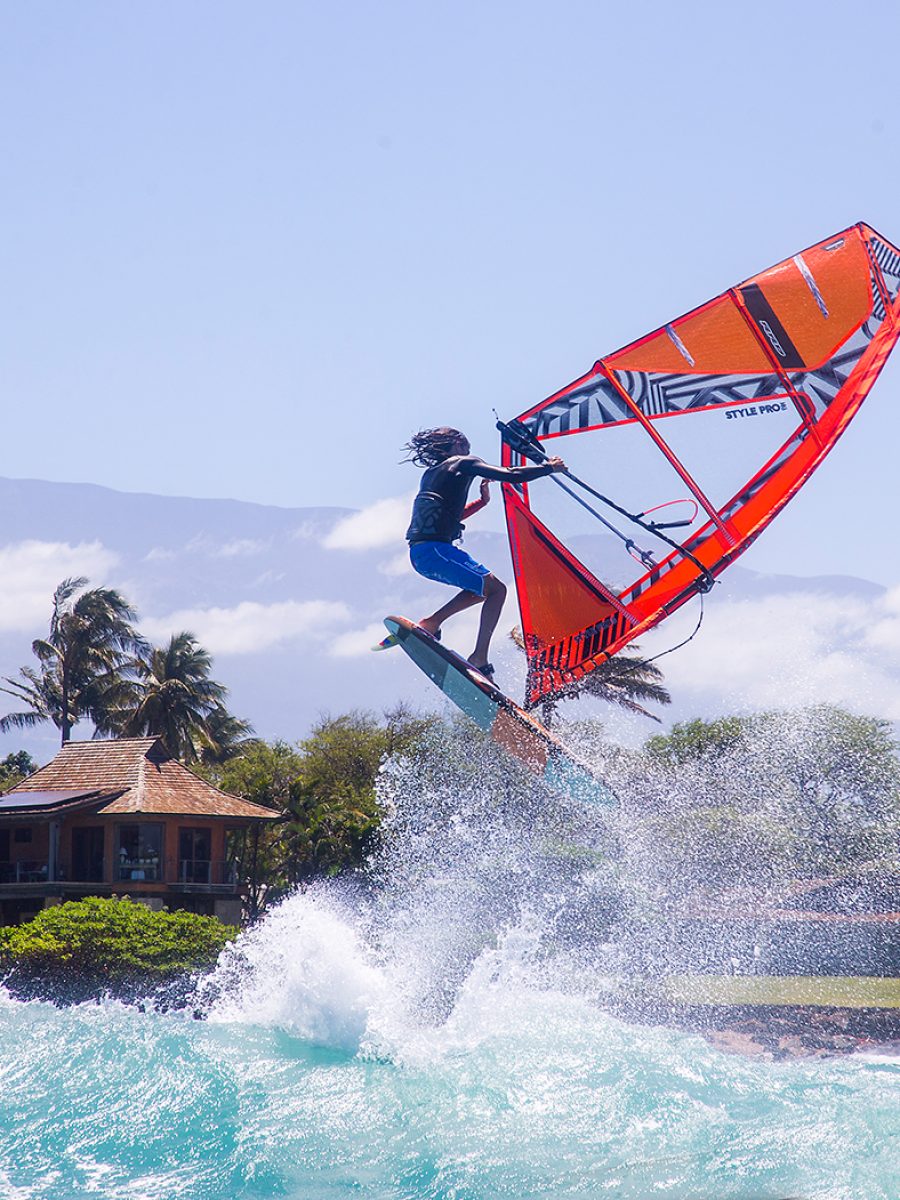
2017 was a banner year for RRD freestyle sensation Jacopo Testa, winning the European Freestyle Pro Tour and finishing 3rd in the PWA freestyle rankings. We take a closer look at his success with words from the man himself and John Skye and Matteo Guazzoni from RRD who also give us an insight into their team and freestyle kit development program.
Words John Skye, Jacopo Testa & Matteo Guazzoni // Photos John Carter
Originally published within the March ’18 edition.
JOHN SKYE – RRD SAIL DESIGNER
This year has been amazing for Jacopo Testa. He has always shown a lot of talent the last few years, but was so chilled and relaxed I had the feeling he didn’t have enough drive to really step up so high. Clearly I was very wrong!!! This year he showed his skills in a huge variety of conditions and more importantly performed really well under pressure. He came back from last to first in Lanzarote in the double Elimination of the EFPT, beating a load of really top riders in the process. I think that really built his confidence up, because since that moment he was right at the top in both EFPT and PWA. To me this is all the more impressive since I think he is actually better with wind from the other direction, especially his aerial jumping freestyle. Most of the freestyle was with wind from the left, but I think he would be even more amazing with wind from the right. This year in Maui during our photoshoot he blew me away with his level. We were shooting at Baby beach, which is the classic small wave jumping spot where lots of the best brochure shots come from. He was sailing so impressively that at one point I actually just dropped my sail on the inside, sat on my board and watched him! Everything in the air was high, controlled and clean. I would like to claim it is the sail that makes it all possible, but when I use the sail it doesn’t do the same thing ha ha ha.
STYLE PRO
Our freestyle sail – the Style Pro – originally took shape around 7 years ago, actually starting with Adam Sims when he was riding for us. Originally we had the Super Style, which was a classic old style freestyle sail, which meant a 5 batten powerful wave/freewave sail, which has since become our infamous Move. At this time it gave the best balance of power to get moving quickly, speed, manoeuvrability and control, with the control mainly meaning stability. Most of the moves were sliding based at the time and speed was really important. This sail is still the best go to sail for 95% of riders, especially those that sail onshore, or bump and jump style conditions. However after testing he found he actually preferred our pure wave sail for freestyle because he preferred to sacrifice some power in order to gain control for the ducking moves. The direction of freestyle at the time was that ducking was the most important feature, so we went back to the drawing board to make something completely new. I pretty much took our wave sail and then tried to work out a way to put a tonne of power in it, without adding any shape. At that time the way we did it was mainly to increase the width of the luff tube, to increase the amount of material at the front of the sail. This meant the sail was totally flat when sheeted out, but when you sheeted it in, it filled in like a balloon. Since then it has developed massively and thanks to the use of varying amounts of Dacron we have been able to create a similar amount of power, whilst reducing the luff tube width and therefore increasing the control, particularly when overpowered. The dacron has much higher stretch characteristics than most of the other materials in the sail, so by making a wide and stretchy panel right at the front we could create a similar balloon effect, but keep it a bit more controlled. It allowed us to modify the width of this panel and the number of layers to control the amount of stretch much more accurately through the sail, thereby allowing us to be much more specific where we wanted this boost of power to be positioned. The reduction of the luff sleeve width meant that the reaction from the sail was much more direct and also controllable.
POWER
The main difference with a freestyle sail is the ability to go from zero power and 100% control, through to huge amounts of power in an instant. The Style Pro is the most reactive sail in our line and if you are not used to the way the power goes on and off, it can be a little harder to handle. Comparing it with a standard wave sail, like the Vogue, the wave sail is more stable and the power comes on and off more progressively, which is more controllable. For sure you could wave sail with a freestyle sail and I know people that particularly like it for light wind riding conditions. However the power in a wave sail is typically a bit lower and a little further back which helps keep control when riding, and allows the rider to drive through turns better. Meanwhile the freestyle sail has the power higher and further forward which is less useful when riding, but great for powering them through freestyle moves. Additionally the aggressive way that a freestyle sail switches on and off makes smooth riding a bit harder, particularly setting rails going into bottom turns. There are other differences as well such as the tight leech and the higher aspect ratio. The tight leech stops the sail moving around too much in moves and keeps everything locked and controlled when ducking. They are basically feeding the sail into the wind, and a loose leech means that if the duck is not perfect the wind can easily catch the wrong side and unbalance the sail. The higher aspect ratio does 2 main things. Firstly it makes ducking easier and more importantly faster because the boom is shorter and secondly it speeds up horizontal rotations, which is what all the freestyle moves are. We also modified the batten angles, making them more angled, which created more support through the whole sail and makes it all a bit stiffer, which again makes the ducking quicker and easier. Everything is designed so that they can duck the sail quickly and easily whilst maintaining as much speed as possible. Like this they can set up their moves in control and then explode into the air when they need to.
STYLE PRO
Our freestyle sail – the Style Pro – originally took shape around 7 years ago, actually starting with Adam Sims when he was riding for us. Originally we had the Super Style, which was a classic old style freestyle sail, which meant a 5 batten powerful wave/freewave sail, which has since become our infamous Move. At this time it gave the best balance of power to get moving quickly, speed, manoeuvrability and control, with the control mainly meaning stability. Most of the moves were sliding based at the time and speed was really important. This sail is still the best go to sail for 95% of riders, especially those that sail onshore, or bump and jump style conditions. However after testing he found he actually preferred our pure wave sail for freestyle because he preferred to sacrifice some power in order to gain control for the ducking moves. The direction of freestyle at the time was that ducking was the most important feature, so we went back to the drawing board to make something completely new. I pretty much took our wave sail and then tried to work out a way to put a tonne of power in it, without adding any shape. At that time the way we did it was mainly to increase the width of the luff tube, to increase the amount of material at the front of the sail. This meant the sail was totally flat when sheeted out, but when you sheeted it in, it filled in like a balloon. Since then it has developed massively and thanks to the use of varying amounts of Dacron we have been able to create a similar amount of power, whilst reducing the luff tube width and therefore increasing the control, particularly when overpowered. The dacron has much higher stretch characteristics than most of the other materials in the sail, so by making a wide and stretchy panel right at the front we could create a similar balloon effect, but keep it a bit more controlled. It allowed us to modify the width of this panel and the number of layers to control the amount of stretch much more accurately through the sail, thereby allowing us to be much more specific where we wanted this boost of power to be positioned. The reduction of the luff sleeve width meant that the reaction from the sail was much more direct and also controllable.
POWER
The main difference with a freestyle sail is the ability to go from zero power and 100% control, through to huge amounts of power in an instant. The Style Pro is the most reactive sail in our line and if you are not used to the way the power goes on and off, it can be a little harder to handle. Comparing it with a standard wave sail, like the Vogue, the wave sail is more stable and the power comes on and off more progressively, which is more controllable. For sure you could wave sail with a freestyle sail and I know people that particularly like it for light wind riding conditions. However the power in a wave sail is typically a bit lower and a little further back which helps keep control when riding, and allows the rider to drive through turns better. Meanwhile the freestyle sail has the power higher and further forward which is less useful when riding, but great for powering them through freestyle moves. Additionally the aggressive way that a freestyle sail switches on and off makes smooth riding a bit harder, particularly setting rails going into bottom turns. There are other differences as well such as the tight leech and the higher aspect ratio. The tight leech stops the sail moving around too much in moves and keeps everything locked and controlled when ducking. They are basically feeding the sail into the wind, and a loose leech means that if the duck is not perfect the wind can easily catch the wrong side and unbalance the sail. The higher aspect ratio does 2 main things. Firstly it makes ducking easier and more importantly faster because the boom is shorter and secondly it speeds up horizontal rotations, which is what all the freestyle moves are. We also modified the batten angles, making them more angled, which created more support through the whole sail and makes it all a bit stiffer, which again makes the ducking quicker and easier. Everything is designed so that they can duck the sail quickly and easily whilst maintaining as much speed as possible. Like this they can set up their moves in control and then explode into the air when they need to.
The rigging of freestyle sails is really different. They have so little loose leech that it looks wrong. The sail does not release so well and you lose some speed, but they counteract this by having very fast rockered boards, and the control they gain when ducking is essential if they are to do the moves with speed. Weight is also critical so we reduce the reinforcement in the Style Pro, particularly up high in the sail, by not having batten pockets and having reduced thickness of materials through the head. In general these sails are used more on flat water so they don’t have to be built to withstand mast high waves like the wave sails do. Our team also all use the race mast, our Firewing RDM. It is super light obviously, but also a bit stiffer, which the riders like as it stays more balanced in the moves. The way these sails have developed and the direction that freestyle is going at the moment makes these sails very specialised really and not much of what we do with the freestyle sails gets used in the rest of the line. Having said that, what is amazing about the Style Pro is that it actually does all the old style freestyle loads better than the old sails. My moves are pretty old school and also very rusty, but if I take out the latest Style Pro sail my level instantly goes higher, even with the sliding moves. Other than the Compact Wave concept, the Style Pro is the sail I am most proud of for the way it has developed over the years together with the team and has become a real reference sail to the whole freestyle community.
TEAM
Our freestyle team is amazing right now and I am very happy. The freestyle sail is pretty much the only sail in the line that I can’t really test well by myself. My freestyle skills are a little archaic so it’s hard to feel how the sail really works in the high end moves they are doing. I still like to actually sail the protos a lot and try to understand them, but in terms of the finer details it’s really hard as my double air culos are not really up to scratch. Therefore I really rely on the team a lot, and I am really happy with all the guys we have. Jacopo is obviously a key member of that team and has a big input, but the guy that works the hardest on this is Loick Spicher. He is a really good freestyler, but also really good at testing and giving excellent feedback. He has kind of acted as the test team coordinator, taking all the information from the guys and translating their feedback into useful information. Often the hardest thing is actually to translate what the guys feel into real information. Sometimes it’s very hard to communicate specific feelings, and even more so when it’s not in your mother tongue. Loick is firstly very good at that, and secondly speaks about 6 languages, so that really helps when discussing things with the others. On top of him and Jacopo we also have Tonky Frans, who is a legend and has a huge wealth of knowledge and also Francesco Cappuzo who is a bigger build than the others and therefore gives really useful feedback on other points in the sails. Finally our windsurf marketing manager, Matteo Guazzoni, is also an amazing freestyler, being ex- EFPT champion himself, so he also has a big input, often with a more general point of view. All the guys are super picky which I love. As a designer I love that the riders are pushing for perfection. It is much better like this than if they just say everything is great.
This year I was really proud of all the team. I think all the other disciplines of the sport I am still actively competing in so it’s a slightly different view on the team. With the freestyle I have not been competitive at it for 10 years or so, so I look at it and it feels really different. Somehow I feel like an elder advisor over the team, rather than one of the guys. Slightly less with Tonky as we competed together for years in the beginning, but certainly with the other guys I am constantly checking their heats and scores and watching more closely than with anything else. For sure I like to follow Alex Mussolini when he is doing well, but it’s really different with the freestyle team somehow. Jacopo stole the show this year and really it was only Gollito that he couldn’t beat. Even Amado he beat in the EFPT, so he really showed he is one of the top top guys. I really wanted Tonky to do well this year as he was sailing better than ever but I think he was pretty unlucky. He had 1 or 2 heats this year that were so close and he lost by nothing on a couple of dubious decisions. If a couple of things had gone the other way he could easily have been right up there also fighting for the podiums. Loick also stepped up his game and Francesco really shone in Sylt. He is an incredible talent, and a real all-round waterman, the Italian Kai Lenny.. ha ha ha. He is 2 x Italian windsurf wave champion, 3 x Italian kitesurf wave vice champ and this year in Sylt he finished 7th in the Freestyle. If you see him, his build is not the typical freestyler’s build as he weighs around 90 kgs, but you see him on the water and he is like a ballerina, but with huge explosive power when he needs it. He is really young still and it will be interesting to see how he develops.
TESTING
Our typical testing schedule revolves mainly around Cape Town and Fuerteventura, but we are still active the rest of the year. Normally in Fuerte we come up with a few different concepts to test. Typically we will choose 1 size, something like a 4.8, and then make 3 or 4 protos trying different things, often quite radical. We test those sails whilst everyone is together and see what the feelings are. Often we then modify these sails, right there in Fuerte, and test them again. From there, we choose the better concepts, look to develop them further and often make a couple more protos for the guys to test in the autumn, with Sylt being the perfect opportunity to at least get everyone together and discuss where we are at. After that we normally aim to really refine the concept and push to make the final set of sails for testing in Cape Town. Normally these go straight into production, but there is still a little room to tweak or modify them further if we think it’s necessary. Then the whole process starts again. I think the freestyle discipline is probably the hardest to design for because the sport is constantly evolving. Slalom is lots of work, but in the end the parameters more or less stay the same each year, for example the sails need to go fast, accelerate well, have power but stay controllable. With freestyle, these parameters are constantly changing as the moves and styles change and develop. A few years ago when we started the Style Pro, the sail needed to duck well and that was the most important thing. Then they needed to duck well and have lots of pop/power. Now it seems like the guys are sailing much more powered up than before and using the wind to really fly. Therefore the emphasis is now really on control, and less about maximising the power. Who knows where it will go next, but it means we are constantly working hard to give the guys the best tools to compete with. This year with all the success of Jacopo Testa and the rest of the team we really proved we have a sail that is capable of doing anything.
JACOPO TESTA
I was born in Milano and grew up in Sardinia where my great love for windsurfing started. I was about 10 years old when, with my brother Matteo, I did my first windsurfing course at Sporting Club Sardinia, from that moment I discovered the meaning of passion. Riccardo, the windsurfing dad of a friend of mine created a team – ‘TNT’. With them I started participating at events in various Italian locations where I met other windsurfing kids and could compare my level and try to improve it. During the summer I spent the windy days trying the moves; we were a big group with a lot of motivation. The beginning was hard because you don’t get tuned in straight away with your board and sail, the sea and wind and your body and its movement. Putting all these elements together was the biggest step. While growing up I wanted so much to change my life. I left the city and moved to Sardinia, started travelling and decided that windsurfing was going to be my profession. I hooked up with RRD because Gigi Le Carrò introduced me to them. RRD has become my first real sponsor and together with John Skye we also started a collaborative program for improvement of their boards and sails and we have had great progress so far!
JACOPO TESTA
I was born in Milano and grew up in Sardinia where my great love for windsurfing started. I was about 10 years old when, with my brother Matteo, I did my first windsurfing course at Sporting Club Sardinia, from that moment I discovered the meaning of passion. Riccardo, the windsurfing dad of a friend of mine created a team – ‘TNT’. With them I started participating at events in various Italian locations where I met other windsurfing kids and could compare my level and try to improve it. During the summer I spent the windy days trying the moves; we were a big group with a lot of motivation. The beginning was hard because you don’t get tuned in straight away with your board and sail, the sea and wind and your body and its movement. Putting all these elements together was the biggest step. While growing up I wanted so much to change my life. I left the city and moved to Sardinia, started travelling and decided that windsurfing was going to be my profession. I hooked up with RRD because Gigi Le Carrò introduced me to them. RRD has become my first real sponsor and together with John Skye we also started a collaborative program for improvement of their boards and sails and we have had great progress so far!
DREAMS
My advice to kids wanting to follow my path is to cultivate the true passion that everyone has inside, that force is fundamental for realizing your dreams. I worked for many years at a windsurfing school as an instructor, I did so many courses, seeing so many people and numerous children. The hardest part of that job is to transmit your passion and keep the attention and interest of your students alive. Something you don’t know about me, I would like a farm and to be a farmer! Watch the seeds grow from the earth! For the next months though I’m just sowing the seeds of the new competition season ahead, starting with a trip to South Africa for some training. Bring on 2018!
RESULTS
In 2016 I achieved my first true results. For the second time I got third place overall in the EFPT and 13th overall in the PWA. In my head I said, “Next year I want to be first in the EFPT and be one of the top ten riders in the PWA.” My expectations were exceeded! European champion and third overall in PWA!!! These are unforgettable moments and emotions. My first PWA podium will remain in my mind forever. Every morning I get up to go to ‘work’. Van, equipment, spots, wind, so much desire and sacrifice. Hours of physical and mental training. The body doesn’t abandon you, but sometimes thoughts can make you discouraged, because if you don’t see the results you want you can think about giving up and going back to a ‘normal’ life.
MATTEO GUAZZONI – RRD INTERNATIONAL MARKETING & TEAM MANAGER
Although I deal primarily with marketing, I am still excited by everything to do with the development of our new products, especially our freestyle boards. Having been a freestyle athlete in the past, and still having a passion for it, makes everything easier. In RRD we are lucky to have the workshop where the boards are designed and shaped directly in Grosseto. This year in particular we have an amazing freestyle team. We discuss and decide together which direction the development of our new boards must take. My role is as a bit of a ‘collector’ of ideas between the demands of our riders, Roberto and our shaper. The TwinTip v6 freestyle board was actually born before I joined RRD. The boys and Roberto had added some small changes to the previous version (the v5), which was already a good board. The v6 board keeps the same scoop line, double concave and vee. Our board is extremely easy and comfortable once you step on it. We decided to keep a quite pronounced double concave because we were happy about its stability and control in most conditions, especially when it gets more difficult in choppy water and small waves. Less double concave would probably give more acceleration but would be harder to control. In general the hardest part is to find the best compromise between speed and control.
We have reduced the length from 227 cm to 223 cm, increased the thickness and moved the footstrap positions more forward. A shorter board is easier in both air moves and sliding but the more you shorten it, the more technical it becomes. However this is the direction that all brands are taking. To keep the same volume you need to reduce the length and increase the thickness, trying not to loose sensitivity and reactivity. The freestyle level has risen a lot, the style and type of moves has changed into more air moves and double rotations. What is needed is to have speed and pop to fly higher and a shorter board to reduce the strength needed during those air rotations. Freestyle scoop lines are flat on the tail (no kick) to maximize early planing and have some vee/concave at the centre of the board. The rails are quite sharp at the back while progressively increasing the tuck towards the front. The volume distribution has changed recently, the thickest has to be on the tail and under the stance position in order to keep the board easy planing in both normal and switch stance as well as to maximize the pop. It’s a very technical board program, you need to work constantly with the riders and get their suggestions and feedback, but it’s fun as you have to try to be creative and innovate.
“ My advice to kids wanting to follow my path is to cultivate the true passion that everyone has inside. ”
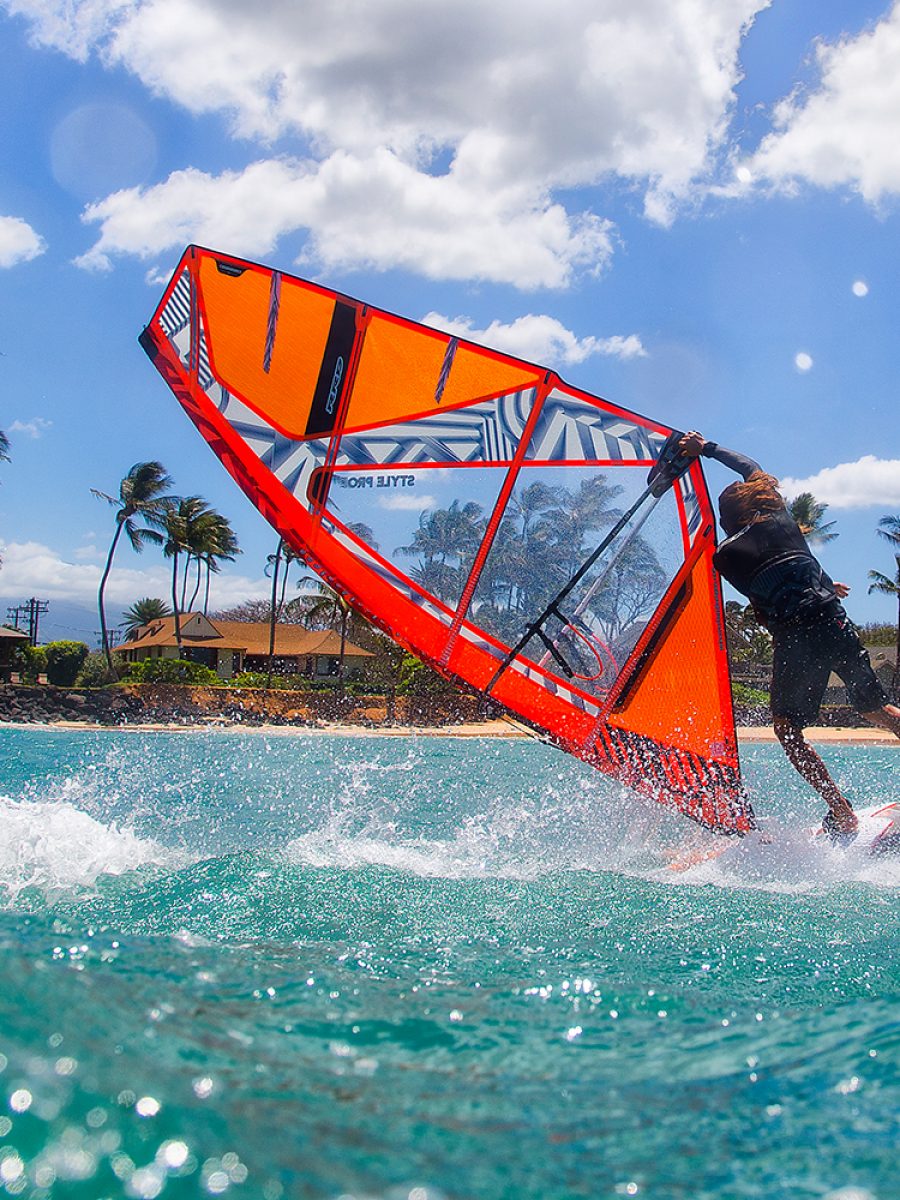
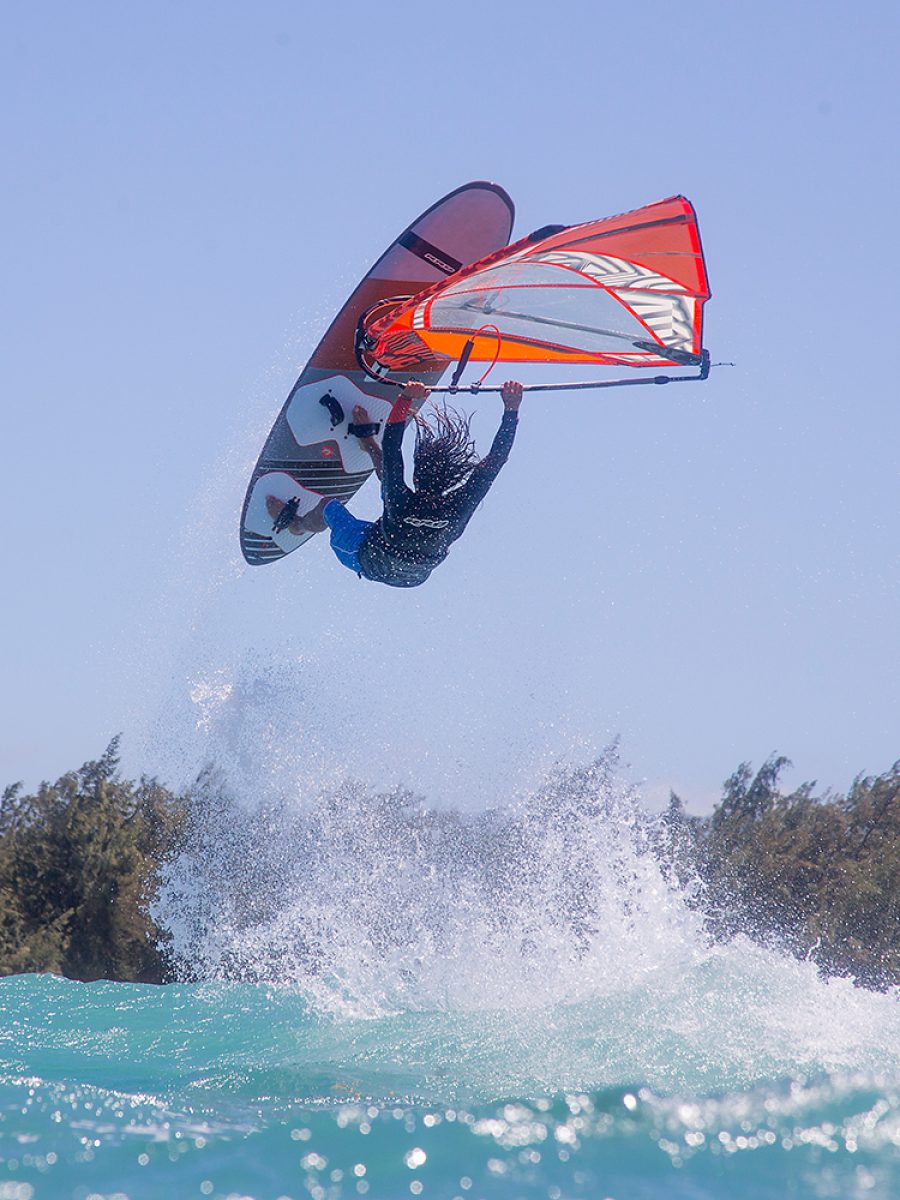
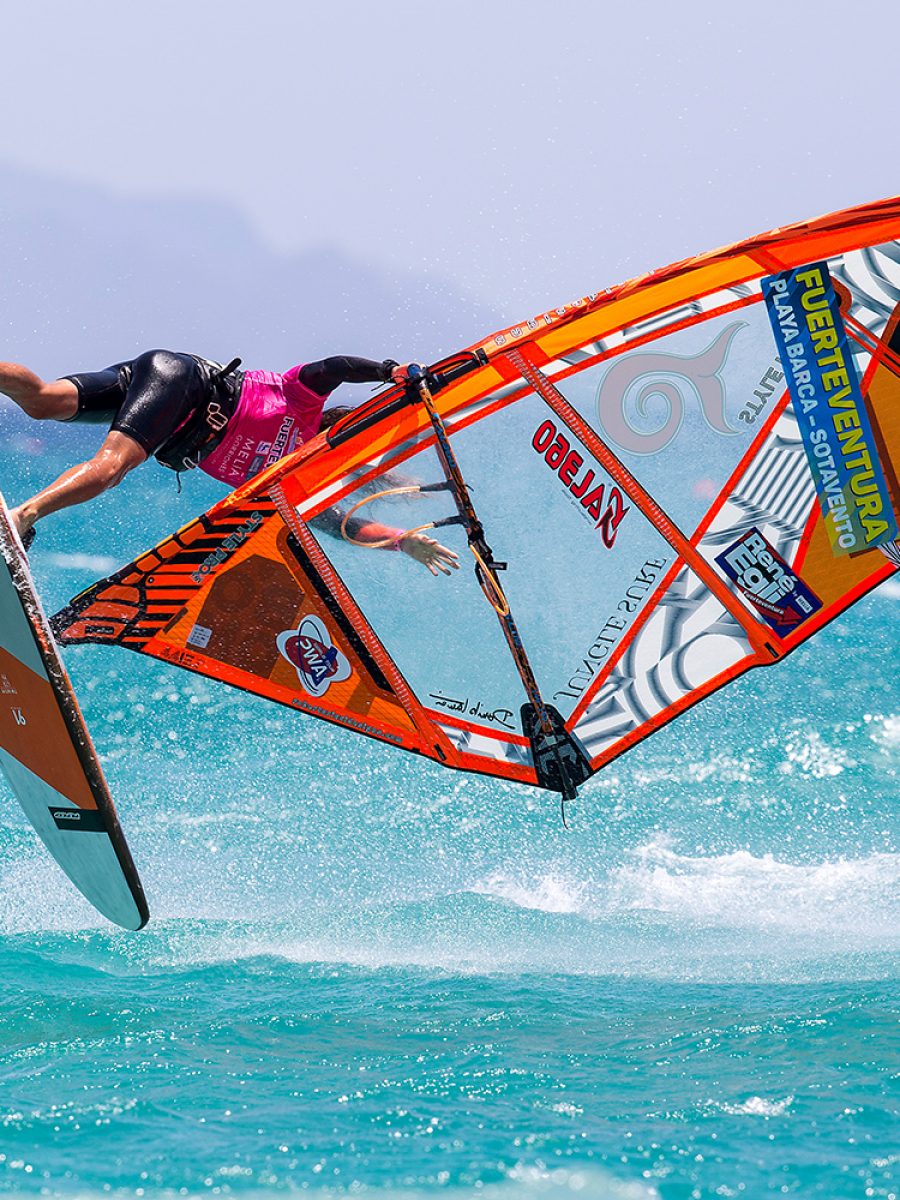
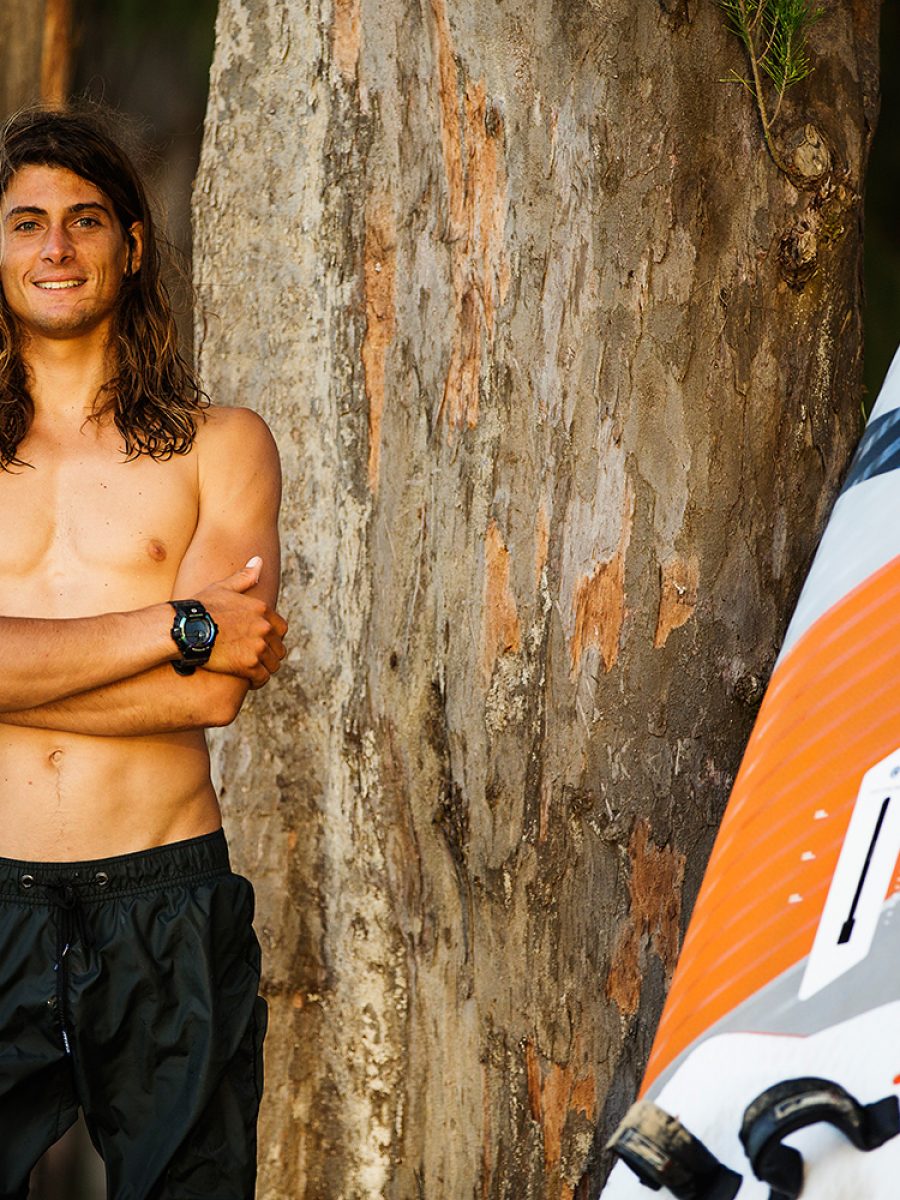
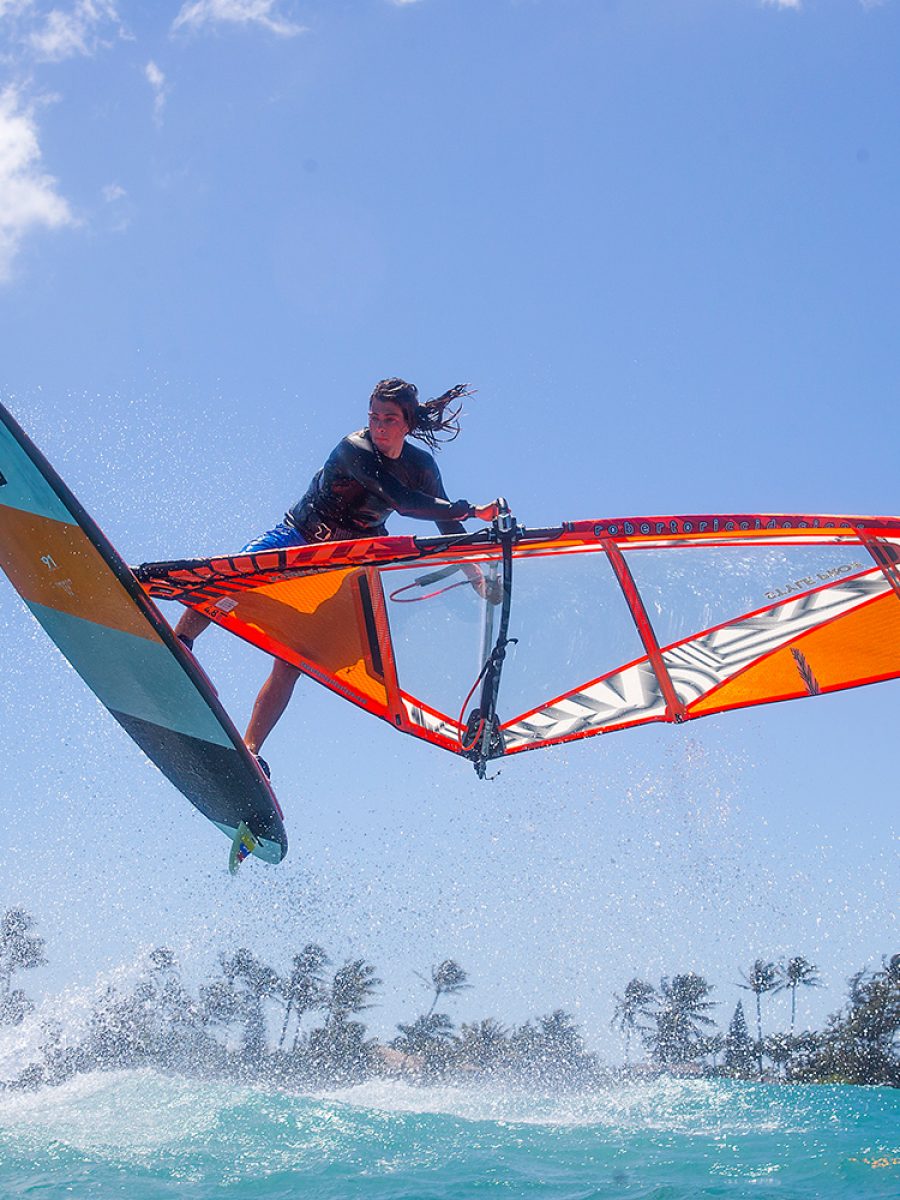
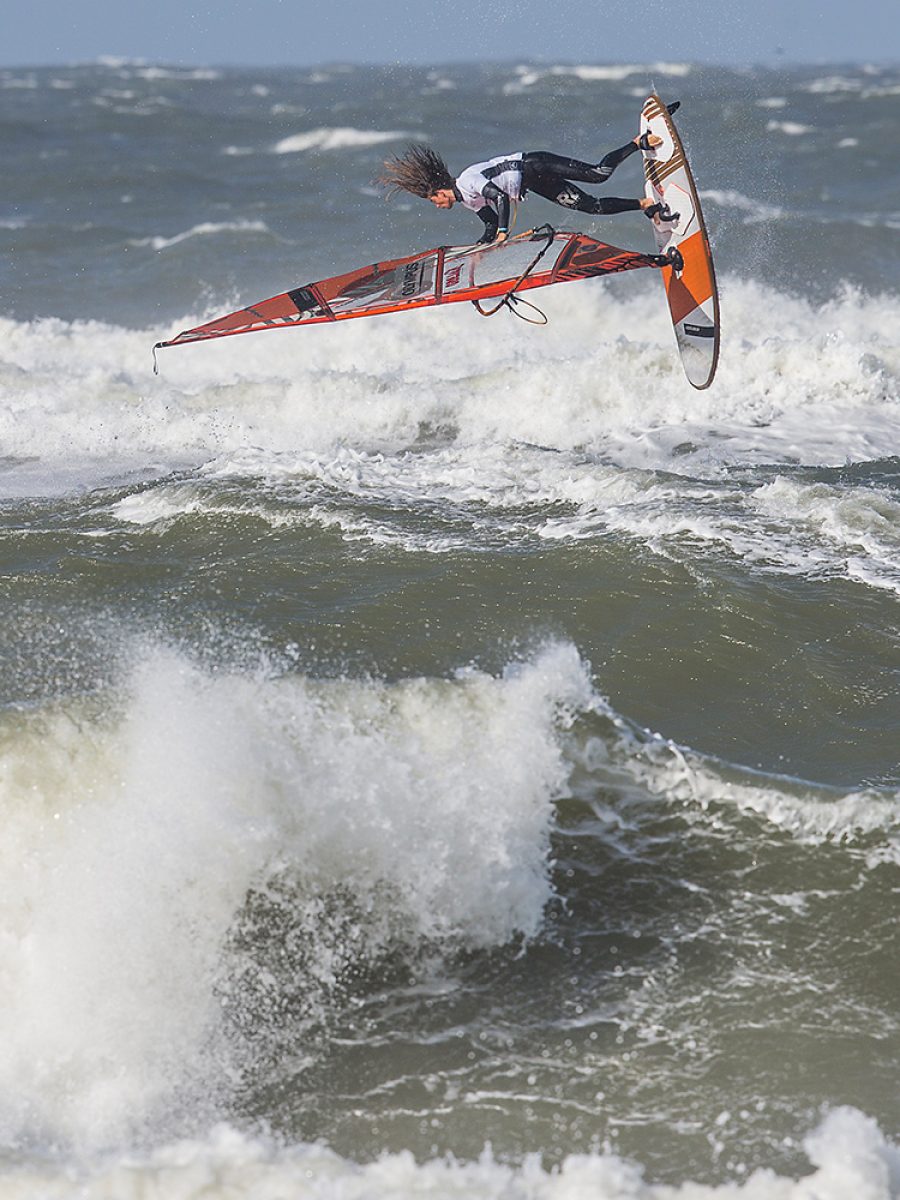

The post FREESTYLE – TRICK FACTORY appeared first on Windsurf Magazine.